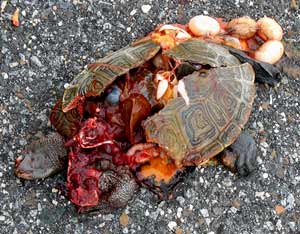|
Creation of New Terrapin Nesting Sites

By Jacob Owens
The diamondback terrapin is a turtle that spends the majority of its life within the waters of the salt marshes and back bays along the Atlantic and Gulf coasts of the United States. The males almost never leave these waters; however, each year the females come on land for a brief period of time to lay their eggs. When searching for a nesting spot the turtles look for an area that follows certain criteria. This site should be close to the salt marsh, in soft enough ground for the turtle to dig, and that is high enough above sea level that it will not be submerged and destroyed by high tides.
Historically in New Jersey these females would venture onto the sand dunes of the barrier islands located only a short distance off the mainland. These dunes met the nesting site criteria of the terrapins perfectly, and also provided an added benefit of being separated from mainland nest predators like raccoons and skunks. Unfortunately, not only did these barrier island dunes provide the perfect site for terrapin nests, they also provided great locations to develop summer homes and vacation spots. The barrier islands of New Jersey have grown into large towns and cities, such as Wildwood and Ocean City, that draw in huge masses of people in the summer. In their attempts to find new nesting spots the turtles now have to cross roadways at the busiest time of year for these vacation hotspots. Thousands of people cross these roads every day, and even at night traffic can be extremely heavy.
 |
 |


Potentially viable eggs can be
retrieved from road-killed terrains.
 | |
Road-killed terrapins number in the thousands each year, and to make matters worse, almost 100% of those killed are nesting females. It is for this reason that the diamondback terrapin is now a “Species of Concern” in New Jersey, and its future looks very grim.
One of the projects that the Wetlands Institute has become involved with is the planning and creation of new nesting sites for diamondback terrapins. As student researchers at the institute, Preston Klingseis and I have been performing the preliminary work on assessing the abundance and diversity of plant and animal species on two islands north of the institute named Gull Island and Sturgeon Island. These were used as dredge spoil deposit sites in the past, but now provide feeding, roosting, and nesting areas for a large number of herons, egrets, and gulls. To date we have seen no evidence of turtle nesting on these sites; however, the majority of the island is not suitable for nesting. Both of these islands are located within the salt marsh and are almost completely covered by a salt marsh grass named Spartina alterniflora. Instead ground material of fine sand or soil, there is only organic matter in which a dense root system resides. Only one small area of one of the islands has a sandy beach on it where terrapins could potentially lay eggs.
The use of dredge spoil to provide terrapins with new nesting sites may potentially become an important part of their furthered conservation and protection. This, along with all of the other measures taken by the Wetlands Institute and their partners, may someday help the diamondback terrapins regain their numbers to healthy levels in New Jersey. The possibility of implementation of these techniques throughout the east coast is very high, so the results of this study may prove to affect terrapin numbers not only in new Jersey but also throughout their range. More work will be done on the soil composition of the dredge disposal sites and the effect of habitat manipulation on the existing wildlife on these islands. The future of the diamondback terrapin is uncertain at this point, but with support from the public, non-government agencies, and local and federal government, we may halt the demise of this amazing and unique species.
|